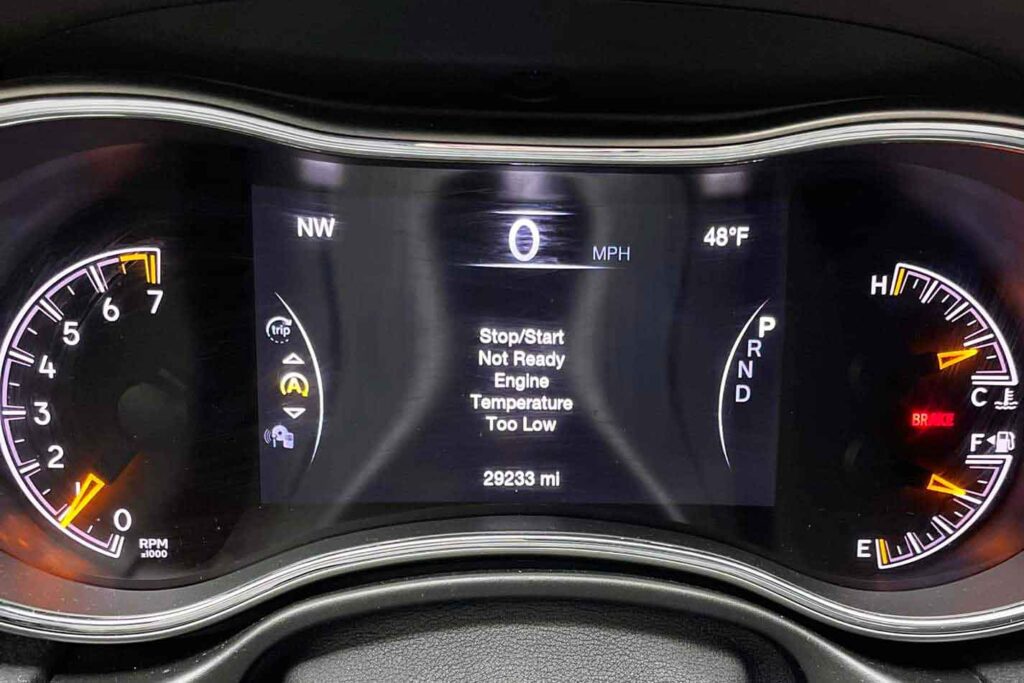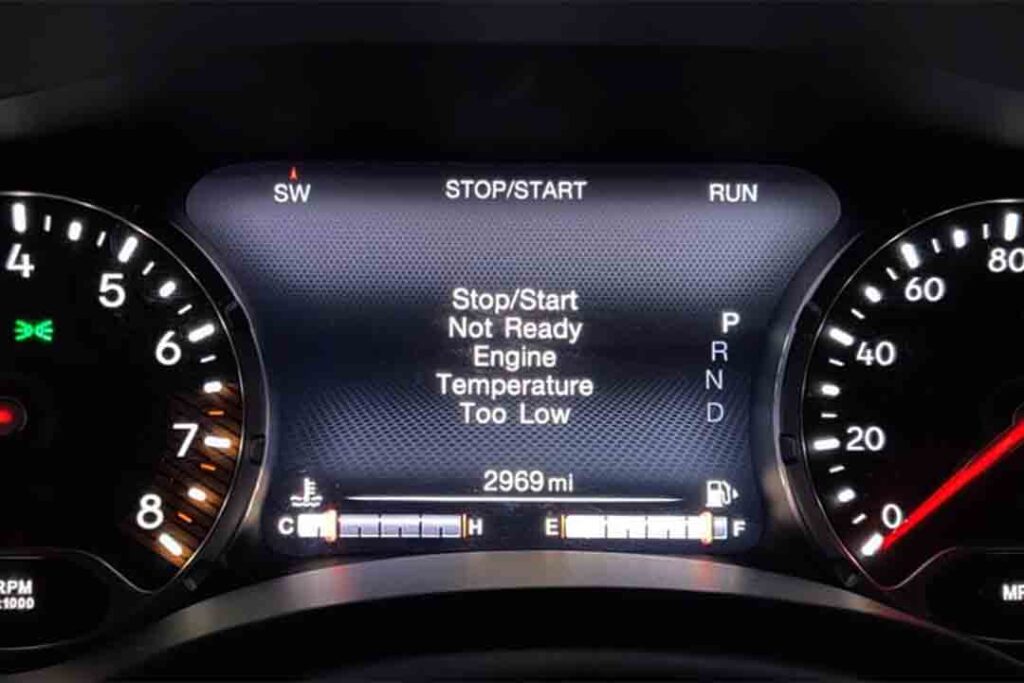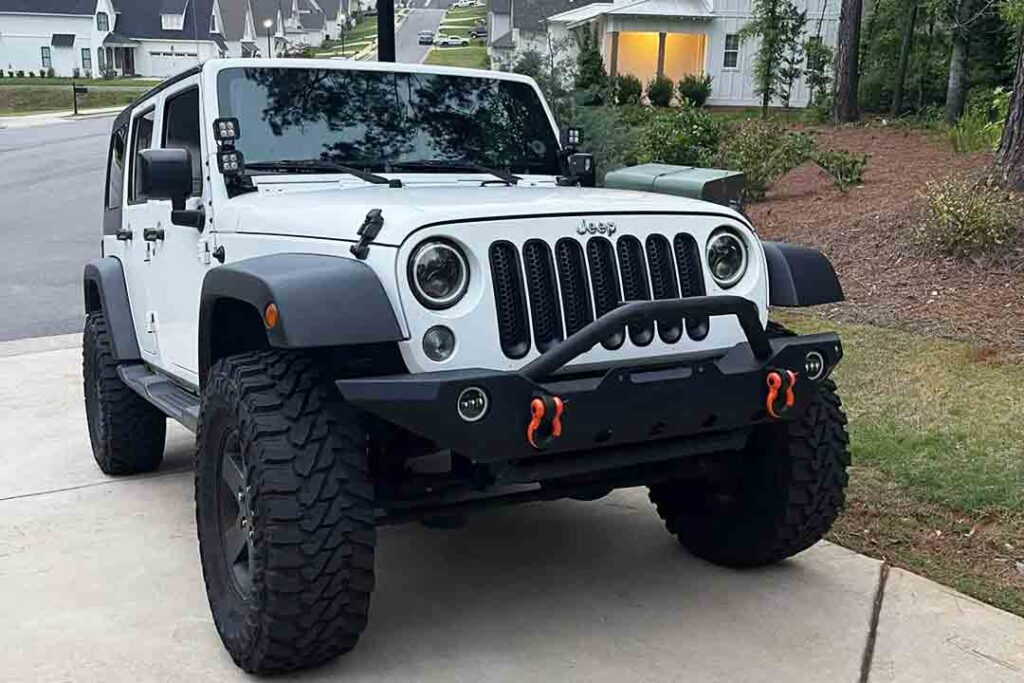Stop Start Not Ready Engine Temperature Too Low: What To Do? [Solved]
The Stop/Start system intends to save fuel and reduce car emissions by minimizing the time your car engine remains idle. Nine of ten newly sold cars today have it, including your Jeep. What happens if it stops stopping? What if it shows an error message like “stop start not ready engine temperature too low”? Why is it happening? Actually, it is not a major issue if you see it only in icy conditions and for a brief amount of time after starting your car. But if the problem persists and you are in hotter conditions too, you might have a thermostat issue, like the wrong temperature thermostat was installed, and you need to check your car by an expert.

Table of Contents
What is a Stop/Start System?
When your car stops at a traffic signal, the Stop/Start system turns off the engine. The engine automatically restarts as soon as you press the clutch pedal again or if you release the brake in an automatic transmission. The Stop/Start technology doesn’t save much fuel, but it greatly reduces noise and emissions. Driving is more economical and ecologically friendly. Because of that, almost all new cars you see on the road are fitted with this system.
How Does it Work?
The Stop/Start system works in unison with other vehicle systems. It communicates with the vehicle’s main computer. It recognizes when you stop your car. Then instructs your car to stop delivering gasoline to the cylinders. The engine restarts when the system detects that you want to move because you have released the brake or dipped the clutch pedal. You don’t need to do anything to restart the engine.
What Causes the “Stop Start Not Ready Engine Temperature Too Low” Warning?
Many parameters must be met to shut off the engine at a stop. One of those conditions is engine temperature. The auto stop/start feature effectively only works when the engine is up to temperature, and starting it is much easier, causing less wear on the starter motor. Sometimes, below 27 °F and above 95 °F, it will not turn off at all.
There are several reasons why the engine is not getting up to temperature. They are-
Malfunctioning Thermostat
The coolant thermostat stops the flow of coolant in the engine by staying closed to warm up the engine. So that the engine reaches operating temperature. Sometimes, the thermostat goes bad or gets stuck open. Then the coolant flows to the engine, preventing it from reaching the optimal temperature quickly.
Faulty Coolant Temperature Sensor
The sensor sends data to the main computer, which controls the stop/start system. The coolant temperature is merely one of the computer’s inputs. The computer will then analyze this data and others before deciding whether to allow the engine to shut down.
When the sensor becomes faulty, it sends inaccurate data. Thus, the PCM disables the system, thinking that the engine temperature is too low when it actually isn’t.
Malfunctioning Engine Coolant Temperature Gauge
When your engine coolant temperature gauge malfunctions because of faulty wiring or the needle getting stuck, it presents an incorrect reading. It shows the engine temperature to be low when the engine has a normal operating temperature. When this happens, the Stop/Start system doesn’t work.
Blocked Radiator
The radiator cools the engine when it is running by cooling the coolant running through the engine. When you’re driving on the highway or the engine isn’t hot enough, it isn’t necessary.
When the radiator gets stuck open because of a faulty sensor or wiring, it keeps the engine temperature too low.
Freezing Conditions
In freezing weather, the engine temperature takes time to get up to its normal operating level. It happens mostly when you start the car for the first time in the morning.
Once the car engine gets up to its normal temperature, it does not require any assistance to stay there when doing routine stop-starts. It takes a long time for a car engine to cool down once it has warmed up.
The car engine can stay warm for a long time, even when it is freezing outside, because of the massive amount of thermal energy it can hold. Furthermore, the radiator stops working when the engine is turned off. This reduces the transportation of heat from the engine even further.

How to Fix the “Stop Start Not Ready Engine Temperature Too Low” Warning?
When you take your Jeep to the dealership, they will say that there’s no problem, everything is fine. It is somewhat normal. They will give it back and tell you to move on. So, before you go to the dealership, you should know the requirements that must be satisfied for the auto Stop/Start to operate.
The engine has to warm up and reach operating temperature. You should check whether the coolant, transmission, and engine oil temperatures are in the cool zone.
Replace Your Thermostat
Check to see if your thermostat is stuck open. Make sure you’re using the right 195-degree thermostat, which will bring the engine up to its normal 210-degree (or near) operating temperature, where it will operate most efficiently.
If you don’t have that, replace the existing thermostat with the correct 195f degree type thermostat. Avoid any designs that claim to be “failsafe,” as they frequently fail in the open position. Avoid thermostats with lower temperature settings, such as 165°F or 180°F. If your Jeep is fully warmed up and the temperature gauge is still not dead in the middle, it’s because your thermostat is stuck in the open position. Replace your stock thermostat with a 195 thermostat.
Replace the Coolant Temperature Sensor
If you are sure that your engine is getting up to normal operating temperature and that the sensor is misreading it, then replace the coolant temperature sensor.
Replace Faulty Gauge
Again, if you’re certain that your engine is heating normally but the temperature gauge isn’t showing it, then you might have a faulty gauge. Replace it. But before that, ensure it’s been properly installed.
Check the Radiator and the Wiring
Make sure there is no loose connection or faulty wiring. Also, check the radiator to make sure it is working properly. To test if the radiator fan is always on, check it. Replace the radiator fan if it becomes faulty.
Run the Engine for a While
If you see the error message, before doing anything, run the engine for a while, especially if it is cold outside. That should solve the problem. If the error persists, then you have a bigger problem, so check the components mentioned above.

What’s the Danger?
Running at a low temperature will do serious harm to your car.
- It may cause poor fuel economy, so to prevent running out of gasoline, keep an eye on its level.
- You’ll see poor performance.
- Your engine will suffer wear and tear.
So take immediate action if you see the error.
Should You Go to a Mechanic?
It depends on when the Stop/Start mechanism fails. If, after driving at speed for more than 20 minutes, it still doesn’t work when you stop, or the temperature isn’t too cold but it doesn’t work, then it’s worth sending your car to the dealership. It’s possible that the thermostat isn’t working or that the battery needs to be replaced. It is best to check out everything before the car breaks down and leaves you stuck somewhere.
Take your Jeep to a regular mechanic who will use a good scanner to ensure that the problem is just the abovementioned issue and not anything more serious.
Some Other Reasons for Stop/Start Not Working:
There can be various reasons why Stop/Start isn’t operating as it should. It usually shows why it is not working on the display. The following situations might also affect the Stop/Start:
- Open driver’s door.
- Too warm or cold battery temperature.
- Low battery charge.
- Unbuckled driver’s seat belt.
- Cabin cooling or heating is ongoing.
- Transmission not in a forward gear.
- Open car hood.
- Brake pedal pressed softly.
- High engine temperature.
These are some possible reasons why the engine may not shut off automatically.
The system will assess several safety and comfort requirements to verify whether they are met before shutting off the engine. The instrument cluster display provides detailed information regarding the operation of the Stop/Start mechanism.
Read More:
- Jeep Commander Transmission Over Temp Problem: How to Fix? [Solved]
- Key Fob Has Left the Vehicle: 5 Tips to Fix the Error
Final Words
It would take a while in the cold for the Stop/Start settings to take effect. This is not a problem; it occurs around the clock as soon as winter arrives. When the engine is cold, Stop/Start will not engage. That might throw the warning message “stop/start not ready engine temperature too low”. The car’s computer is smart enough to recognize that an engine is most efficient when thoroughly warmed up.
Therefore, until the engine reaches the ideal temperature, the computer keeps it running. But if you see the error message after driving for some time or in hot weather. Then you might have a problem with the thermostat or something else. You should follow the above-mentioned steps or consult with your mechanic.
